How to Draw Cpm Network Diagram
Critical Path Method (CPM) is a project schedule modeling technique. Mr. Morgan R. Walker and James East. Kelly adult this technique in the late 1950s.
Project planners use this method to develop schedules for projects, including IT, research, and structure.
Critical Path Method is a lengthy and complex concept. Please follow each footstep in this blog post, and don't motility on until you sympathize the previous steps. If yous follow this advice and complete the blog mail service, you won't have any problems solving Disquisitional Path Method questions on the PMP Exam.
Critical Path Method
In the disquisitional path network method, you focus on managing the disquisitional path.
A network diagram has many paths originating from 1 point and ending at another bespeak. Every path has a duration, and the i with the longest duration is the disquisitional path.
Y'all can ascertain a disquisitional path every bit:
- The longest path in the network diagram, or
- The shortest duration to consummate the project.
Discover that the first argument talks nearly the longest path, and the other talks about the shortest duration.
They may appear to be opposites, only they are conveying the same message.
For case, allow's say you have a project to construct iii buildings. The beginning is the largest, the second is medium-sized, and the third is the smallest.
You develop the network diagram, which comprises 3 paths, each representing a building.
Y'all calculate the elapsing for each path. For the starting time building, the duration is 31 months, the second volition have eighteen months, and the third will crave 13 months.
You can see that the commencement path is for the largest edifice, the second path is for the medium-sized one, and the third path is for the smallest building.

Now, allow the states review the diagram for the disquisitional path analysis.
Did you notice that the first path is the longest?
It is 13 months longer than the second and xviii months longer than the third.
This means that you can expect 13 months and and then start working on the second building because you tin can consummate the second building in 18 months.
Too, you could wait eighteen months and then start working on the third building because it will have thirteen months to complete. This means that, fifty-fifty if you kickoff work on the third building after eighteen months from the project beginning engagement, you can finish information technology on time.
This waiting menstruum is known as the float or slack.
Then, which is the critical path in this network diagram?
It is the longest path on the network diagram because you cannot complete your project earlier finishing the first building. Although you tin can complete the other two buildings quickly, your projection is not considered complete until the get-go edifice is completed.
This confirms the first statement that says, "the disquisitional path is the longest path on the network diagram."
At present, what is the shortest duration to complete the project?
It is 31 months considering you cannot complete your projection in less time, and this is the duration of the critical path.
This bears out the second statement that says, "The critical path is the shortest elapsing in which yous tin can complete the projection."
So, both definitions are the same.
Y'all tin define the critical path every bit the sequence of activities from start to end, and it has the longest duration of all paths in a network diagram.
In ideal weather, a network diagram should take one disquisitional path. Multiple critical paths volition put you in a difficult situation.
The critical path has the longest duration, and information technology is the total projection's duration. Activities on the critical path have no float; therefore, you must ensure those critical activities are completed on time. Any delay in a critical activity (critical path activity) will delay the project.
What if the projection is delayed?
Schedule slippage is mutual in project management. Nevertheless, some tools tin can help you bring things dorsum on schedule. These are called schedule pinch techniques, and Fast-tracking and Crashing are two examples. If your project is behind schedule, you lot can use these tools to become it back on time.
Visit: Fast Tracking and Crashing
A Few Commonly Used Terms in Critical Path Method
Before I start discussing how to find the disquisitional path, let usa understand a few common terms used in a critical path network diagram:
Earliest Commencement Time or Early Beginning (ES): This is the earliest fourth dimension an action can be started in your project.
Latest Kickoff Time or Late Start (LS): This is the latest fourth dimension that an action tin can be started on your project. If y'all start the activity beyond this fourth dimension, it will affect your disquisitional path.
Earliest Finish Fourth dimension or Early End (EF): This is the earliest time an activity is completed in your project.
Latest Finish Time of Tardily Finish (LF): This is the latest fourth dimension you can complete the activity on your projection. If your activity crosses this time, your projection will be delayed.
How to Find the Critical Path in a Network Diagram
Now nosotros have reviewed critical path method terminology, let'south see how we can calculate the critical path, belatedly start, early start, late terminate, and early end:
- The start stride is to collect all projection activities. Y'all can employ the work breakdown structure to find tasks for your project.
- After listing project activities, find the task dependencies amongst the activities. Notice which activity will follow what activity and chore relationship such as cease to commencement, finish to terminate, showtime to kickoff, or start to finish.
- Now, describe the network diagram and assign durations to each activity.
- Place all paths in the network diagram.
- Find the duration of each path.
- The path with the largest elapsing is the disquisitional path.
- Use forward pass the calculate the primeval outset or early on start, and earliest finish or early finish of each activity.
- Use backward pass the calculate the latest get-go or late start and the latest terminate or belatedly finish for each activity.
- Now you can calculate the bladder for all activities.
- Note that on a disquisitional path, a late start will be equal to a late end, and an early start will exist equal to a late start. Also, all critical path activities will have no float.
This data lets you draw the critical path network diagram, and you lot volition know the float of each activity. You will how much yous can filibuster a detail task, and any delay beyond this point volition impact the project schedule.
Critical Path Method Example
Based on the network diagram beneath, identify the total paths, critical path, and float for each path.
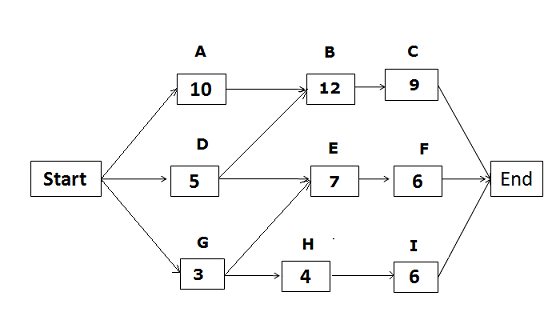
The in a higher place network diagram has v paths. The paths and their durations are as follows:
- Start -> A -> B -> C-> End {duration: 31 days.}
- Start ->D -> E ->F -> Stop {elapsing: 18 days.}
- First -> D -> B -> C -> Cease {elapsing: 26 days.}
- Get-go -> G ->H ->I -> End {duration: 13 days.}
- Start -> Chiliad -> E ->F -> Terminate {duration: xvi days.}
Since the duration of the first path is the longest, it is the critical path. The bladder on the critical path is zip.
The float for the second path "Start ->D -> East ->F -> End" = duration of the critical path – duration of the path "Start ->D -> E ->F -> Terminate"
= 31 – 18 = xiii
Hence, the bladder for the second path is xiii days.
Using the same process, we can calculate the float for other paths as well.
Float for the 3rd path = 31 – 26 = v days.
Float for the fourth path = 31 – xiii = 18 days.
Float for the 5th path = 31 – 16 = 15 days.
Calculate Early Start, Early on Terminate, Late Commencement, and Late Finish
We have identified the disquisitional path and the duration of the other paths. Now it's fourth dimension to move on to more advanced calculations: Early Commencement, Early Finish, Late Beginning, and Late Terminate.
Calculating Early on Start (ES) and Early Finish (EF)
To calculate the Early on Kickoff and Early Finish dates, we use the forward pass; we will get-go from the beginning and proceed to the end.
The Early Start (ES) for the first action on any path will be one because you lot cannot get-go the activity earlier the first twenty-four hour period of your project.
The starting signal for any activeness is the endpoint of the predecessor activity on the same path (plus one).
The formula used for computing Early Start and Early Finish dates:
- Early Beginning of the activity = Early Terminate of predecessor activity + 1
- Early Finish of the activity = Activity elapsing + Early on Start of activeness – 1
Early on Start and Early Terminate Dates for the path Start -> A -> B -> C -> Terminate
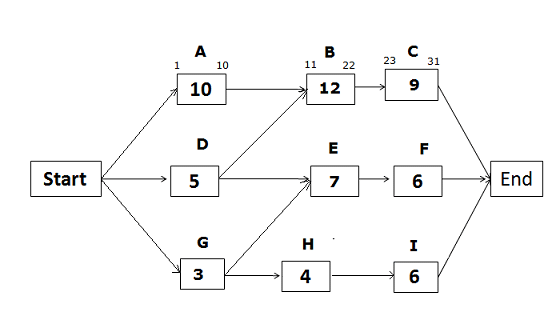
Early Start of action A = ane (Since this is the outset activity of the path)
Early Finish of activity A = ES of action A + activity duration – ane
= 1 + ten – 1 = 10
Early on First of activity B = EF of predecessor activeness + 1
= 10 +1 = 11
Early Finish of activity B = ES of activeness B + activeness duration – i
= 11 + 12 – 1 = 22
Early First of activeness C = EF of predecessor activity + 1
= 22 +1 = 23
Early Stop of activity C = ES of activity C + activeness duration – ane
= 23 + 9 – 1 = 31
Early Start and Early on Finish Dates for the path Starting time -> D -> E -> F -> Finish
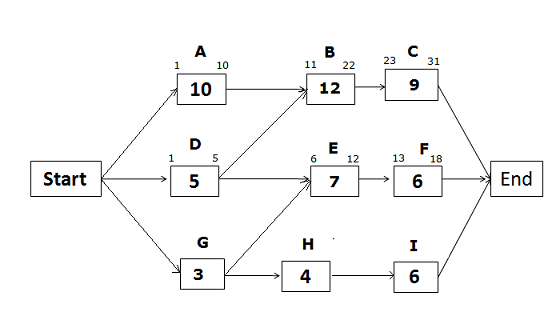
Early Start of activity D = i (Since this is the first activeness of the path)
Early End of activity D = 1 + 5 – one = 5
Early Start of activity Eastward = EF of predecessor activity + 1
Since activeness Eastward has ii predecessor activities, which one will you select? The answer is the activity with the greater Early Finish date. The Early Finish of activeness D is five, and the Early Finish of activity G is iii (we will calculate information technology later).
Therefore, we will select the Early on Finish of activity D to find the Early Start of activity E.
Early Start of activeness E = EF of predecessor activeness + one
= five + 1 = 6
Early on Finish of activeness Eastward = half dozen + 7 – ane = 12
Early Start of activity F = 12 + 1 = 13
Early Finish of activeness F = xiii + half dozen -1 = xviii
Early Commencement and Early Finish Dates for the path Starting time -> Chiliad -> H -> I -> Stop
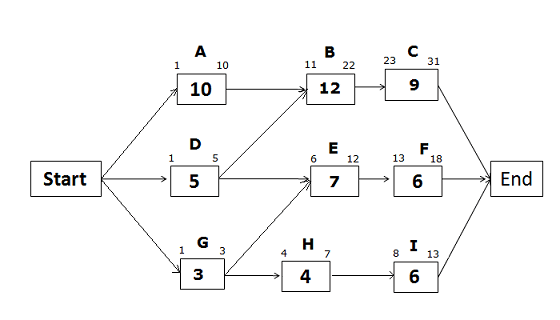
Early Showtime of activeness G = i (Since this is the get-go action of the path)
Early Stop of activity G = ane + three – i = 3
Early Start of activity H = 3 + ane = 4
Early Finish of activity H = 4 + 4 – one = seven
Early Start of activity I = 7 +1 = eight
Early Stop of activity I = 8 + half dozen – 1 = 13
Calculating Late Outset (LS) and Tardily Finish (LF)
We have calculated the Early Start and Early Finish dates of all activities. At present it is fourth dimension to calculate the Tardily Start and Belatedly End dates.
The Late Finish engagement of the terminal activity on all paths will be the same because no activities tin continue once the project is completed.
The formula used for Late Beginning and Late Terminate dates:
- Late Start of Action = Late Finish of activity – action duration + 1
- Late Stop of Activity = Late Get-go of successor action – one
To calculate the Late Start and Belatedly Finish, nosotros utilise the backward pass; i.e. we will start from the last activity and move back towards the first activity.
Late Start and Tardily Finish Dates for the path Start -> A -> B -> C -> End
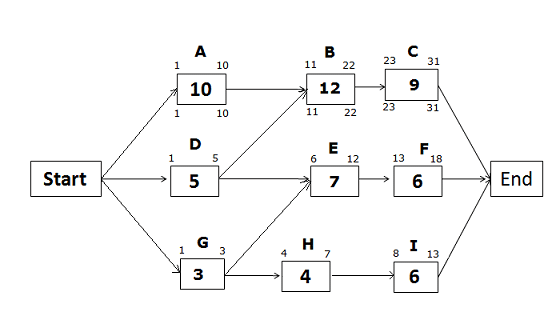
On a critical path, the Belatedly Starting time, and Late Cease dates will exist the aforementioned as the Early Start and Early Finish dates
Late Start and Tardily Finish Dates for the path Start -> D -> E -> F -> End
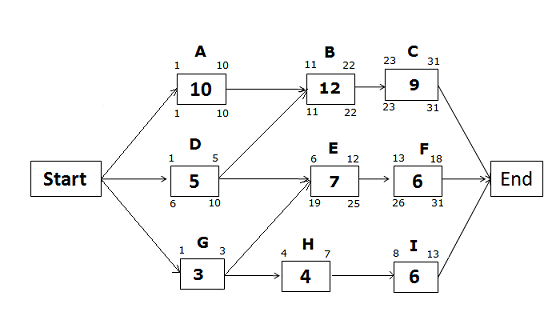
Late Finish of activeness F = 31 (because you lot cannot allow any action to pass the project completion date)
Late Starting time of activity F = LF of activity F – activity duration + i
= 31 – 6 +1 = 26
Late End of Activity Eastward = LS of successor action – 1
= LS of Activity F – 1
= 26 – 1 = 25
Tardily Start of Activity E = LF of activity E – activity duration + 1
= 25 – 7 + one = 19
Belatedly End of activeness D = LS of successor activeness – 1
If you expect at the network diagram, you volition notice that activeness D has two successor activities, B and E. Then, which action would y'all select?
You lot will select the activity with the earlier (least) Late Offset date. Here, the Tardily First of activity B is 11, and the Late Start of activity E is 19.
Therefore, you will select activity B, which has the earlier Belatedly Commencement date.
Hence,
Late Finish of activity D = LS of activity B – i
= 11 – one = 10
Late Start of Activity D = LF of activity D – activity duration + 1
= 10 – 5 + 1 = half dozen
Tardily Beginning and Late Finish Dates for the path Showtime -> G -> H -> I -> Finish
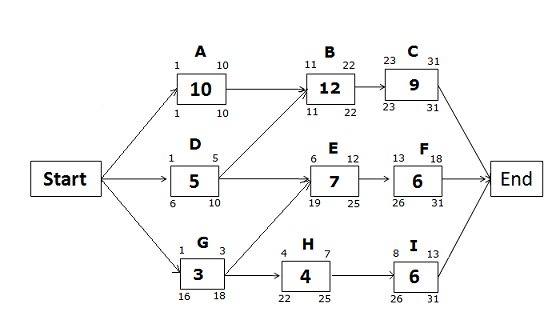
Late Finish of activity I = 31 (because you cannot permit any action to pass the project completion date)
Tardily Starting time of action I = 31 – half-dozen + 1 = 26
Late End of activity H = 26 – 1 = 25
Late Start of activity H = 25 – 4 + ane = 22
Late Stop of Activity Thou = 19 – 1= 18 (we will choose the belatedly first of activity E, not activity H because the Late Showtime of activity Due east is earlier than the Late Starting time of activity H).
Tardily First of activity One thousand = 18 – three + ane
= 16
Summate the Free Float
I recommend that you read my web log post on the total float and costless bladder to go a ameliorate understanding earlier proceeding further.
Visit: Full Float and Free Float
The formula for the Complimentary Float is:
- Free Bladder = ES of next activity – EF of electric current activity – 1
Benefits of the Critical Path Method
The post-obit are a few benefits of the Critical Path Method:
- It shows a graphical view of the project.
- Yous can find and visualize dependencies.
- It aids in project planning, scheduling, and controlling.
- It helps in contingency planning.
- Yous tin can see the critical path and identify critical activities.
- It helps you assign the float to activities and flexibility to float activities.
- It shows you where yous tin can accept action to bring projects back on track.
Drawbacks of the Critical Path Method
Although the critical path is a very useful tool in project planning, it has some drawbacks, such equally:
- The Critical Path Method is an optimal planning tool and assumes that all resources are always available for the project.
- It does non consider resource dependencies.
- There is a take chances of misusing float or slack.
- Less attending is paid to non-critical activities, though sometimes they may become critical activities.
- Projects based on the disquisitional path often do not finish on fourth dimension.
- For complex project you lot volition need to use project management software to develop the critical path scheduleing that will add cost to your project.
To overcome these shortcomings, the Critical Chain Method (CCM) was developed.
Visit: Critical Chain Method in Projection Management
Apart from the CCM method, many project planners employ schedule based on the Gantt nautical chart.
Summary
The Critical Path Method has helped many project managers develop and manage schedules. It is a skillful communication tool, and it helps secure stakeholder buy-in. A network diagram has many paths, but y'all must focus on the disquisitional one. Whatsoever filibuster in critical activity will affect the project schedule. Monitor floats on other paths considering if the float drops to zero, that path volition get a disquisitional path, and you should avert this.
As a project manager, you must monitor your network diagram and take prompt corrective action whenever necessary.
Are you involved with project planning? Delight share your experience with the Critical Path Method in the comments section.
This is an of import topic from a PMP exam betoken of view. Y'all will come across many questions in your exam on this topic.
Source: https://pmstudycircle.com/critical-path-method-cpm-in-project-management/
0 Response to "How to Draw Cpm Network Diagram"
Post a Comment